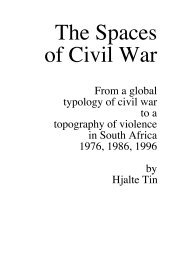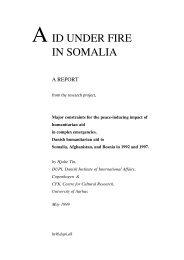wfp, food aid and local survival in guinea-bissau, 1998-99 - Nina ...
wfp, food aid and local survival in guinea-bissau, 1998-99 - Nina ...
wfp, food aid and local survival in guinea-bissau, 1998-99 - Nina ...
You also want an ePaper? Increase the reach of your titles
YUMPU automatically turns print PDFs into web optimized ePapers that Google loves.
Hjalte T<strong>in</strong> : Food Aid <strong>in</strong> Gu<strong>in</strong>ea-Bissau <strong>1<strong>99</strong>8</strong>-<strong>99</strong>. June 2001 ; page 23<br />
Table 3.<br />
Food consumption <strong>and</strong> <strong>food</strong> <strong>aid</strong> <strong>in</strong> Gu<strong>in</strong>ea-Bissau 1<strong>99</strong>7/98/<strong>99</strong>/00<br />
Harvest year<br />
1<strong>99</strong>7/<strong>1<strong>99</strong>8</strong> <strong>1<strong>99</strong>8</strong>/1<strong>99</strong>9 1<strong>99</strong>9/2000<br />
1Nov/31 Oct<br />
Population 1.112.000 1.134.000 1.157.000<br />
National consumption 161.500 tons 150.385 tons 153.080 tons<br />
Average consumption<br />
Day/person a)<br />
400 grams<br />
1.500 kcal<br />
363 grams<br />
1.360 kcal<br />
362 grams<br />
1.360 kcal<br />
Aid consumed 7.387 tons b) 2.858 tons c) 10.286 tons d)<br />
Aid % of consumption 7,8 % e) 5,7 % f) 6,7 % g)<br />
Aid contribution to<br />
Average consumption<br />
117 kcal<br />
day/person<br />
78 kcal<br />
day/person<br />
91 kcal<br />
day/person<br />
Source: CILSS; <strong>1<strong>99</strong>8</strong>, 1<strong>99</strong>9, 2000; WFP Gu<strong>in</strong>ea-Bissau<br />
a) Equivalent of 90% rice <strong>and</strong> 10% oil. Nutritional values calculated from WHO 2000:194<br />
b) Total <strong>food</strong> <strong>aid</strong> distributed June-December <strong>1<strong>99</strong>8</strong>; cf. Table 1<br />
c) Total <strong>food</strong> <strong>aid</strong> distributed Jan-April 1<strong>99</strong>9; cf. Table 1<br />
d ) Food <strong>aid</strong> distributed Jan-Dec 1<strong>99</strong>9; WFP-figure<br />
e) % of Jun-Dec <strong>1<strong>99</strong>8</strong> consumption<br />
f) % of Jan-April 1<strong>99</strong>9 consumption<br />
g) % of Nov 1<strong>99</strong>9-Oct 2000 consumption<br />
Gu<strong>in</strong>ea-Bissau: no fam<strong>in</strong>e reported nor averted<br />
The average consumption before, dur<strong>in</strong>g, <strong>and</strong> after the war (cf. Table 3) was still below<br />
the WHO/FAO full ration of 2.080 kcal per person per day. (WHO 2000:142) Of<br />
course, certa<strong>in</strong> groups may have received more <strong>and</strong> some less than the average ration,<br />
but except for isolated pockets of malnutrition no hunger was recorded by nutritionists<br />
monitor<strong>in</strong>g the situation <strong>in</strong> Gu<strong>in</strong>ea-Bissau. ICRC reported one month <strong>in</strong>to the conflict<br />
when no <strong>in</strong>ternational <strong>aid</strong> had yet reached the population, ”the situation is not altogether<br />
alarm<strong>in</strong>g.” (ICRC Update on activities <strong>in</strong> Gu<strong>in</strong>ea, 98/ 03, July 6, <strong>1<strong>99</strong>8</strong>) The co-ord<strong>in</strong>ator<br />
for the protestant relief agency ACT report<strong>in</strong>g on the situation one month later, 3 aug<br />
<strong>1<strong>99</strong>8</strong>, stated that, ”the <strong>food</strong> situation is not considered critical, but people have no<br />
money to buy <strong>food</strong>”. WFP commisioned a nutritional survey <strong>in</strong> December <strong>1<strong>99</strong>8</strong>. The<br />
report <strong>in</strong>dicated ”no significant malnutrition <strong>in</strong> either IDPs nor <strong>local</strong> population, despite<br />
a reduced overall <strong>food</strong> availability”. (WFP Donor Report 1<strong>99</strong>9) Only some pockets of<br />
malnutrition were identified along the border with Senegal.<br />
Nutritional impact of short-term operations are notoriously difficult to assess partly<br />
because of poor data collected under chaotic conditions, partly because the nutritional<br />
impact of <strong>food</strong> <strong>aid</strong> seldom is long-term but only constitutes a m<strong>in</strong>or part of a highly






